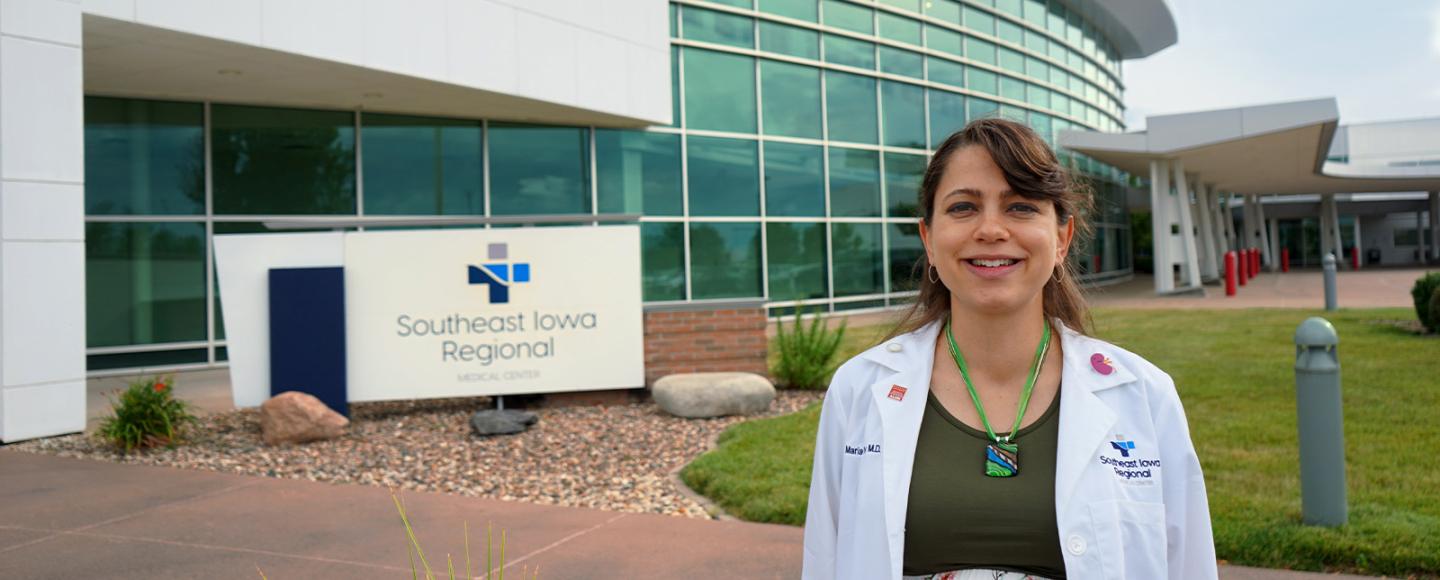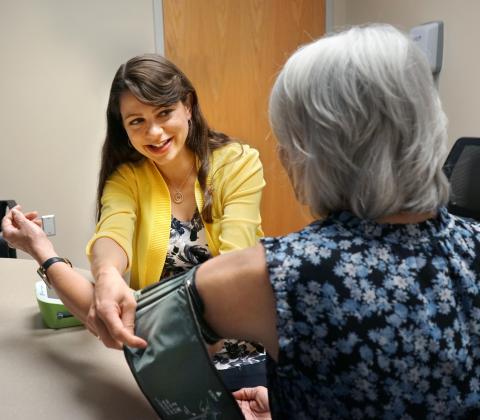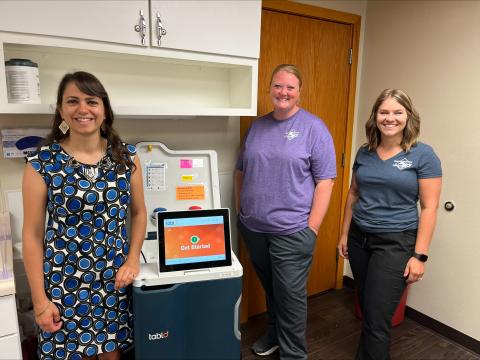Table of ContentsClose

Many of us feel there aren’t enough hours in the day to accomplish everything we want to do. So, what would you do if you could have 12 more hours in your week?
For patients who count on dialysis treatments to help manage their kidney failure, this question isn’t hypothetical. Many of these patients must report to a dialysis clinic three times a week, often for four or more hours, to complete their lifesaving treatments. During this time, they are connected to a dialysis machine in a clinic that, for some, may be 30 miles or more from home. When you account for travel time, the commitment can feel like a part-time job—one that keeps patients alive but also makes it harder for them to work full time, go to school, or care for a family.
Maria Story, (14 MD, 17R, 21F), FACP, FASN, CHS, a nephrologist at Southeast Iowa Regional Medical Center in West Burlington, Iowa, wants to empower dialysis patients to spend more of their time the way they choose.
'Life-changing' new option for southeast Iowans
Story spends much of her time guiding patients through dialysis treatments. Dialysis, which involves cleaning toxins from the blood and removing extra fluid from the body, can be performed in a few different ways, depending on the condition and needs of the patient.
Story noticed that one option was unavailable to patients in southeast Iowa, however.
“There are two types of home dialysis, which is where patients are trained to do the dialysis on their own,” Story explains. “One is called peritoneal dialysis, in which the patient puts sterile fluid into their belly to clean the blood at night while they're sleeping. The other is home hemodialysis, and that involves cleaning the blood through a machine. Sometimes people want to do home dialysis, but peritoneal dialysis just doesn't work for one reason or another. But in southeast Iowa, we didn't have a program for home hemodialysis.”
Taking advantage of the new support for home dialysis created by the 2019 Advancing American Kidney Health initiative, Story and her colleagues launched a program to begin providing home hemodialysis machines and training in collaboration with Southeastern Renal Dialysis. The blood-cleaning machine she mentioned—a mini-fridge-sized system called Tablo—contains all the necessary components for treatment and connects easily to the patient’s home electricity and water lines. After three weeks of training with a specialized nurse, most patients are ready to use Tablo on their own at home, reducing their number of doctor visits from multiple times a week to just once a month. And because a diagnosis of end-stage renal disease automatically qualifies individuals for Medicare, Tablo is covered by the federal insurance program.
“We had one gentleman who was working part-time at his job in a factory because he had to come to the dialysis clinic three times a week,” Story says. “Once he switched to home hemodialysis, he was able to do dialysis at night and on the weekends and returned to a full-time work schedule. That was life-changing for him.”
The program is still getting off the ground and working to hire the staff it will need to grow, but it has been deeply meaningful for the patients enrolled so far. In rural Iowa, the program could improve access for patients who live a long distance from the clinic and help prevent missed treatments due to scheduling conflicts or bad weather.
A cuff and a chip

Another program spearheaded by Story was the establishment of remote patient monitoring programs for hypertension and heart failure. Remote patient monitoring involves providing the patient with a medical device—such as a blood pressure cuff—that they can use independently at home. A chip in the device automatically sends their information to a secure portal. Then, an interdisciplinary team led by pharmacist Audrey Housel, PharmD, reviews the information and adjusts the patient’s medications and instructions remotely.
“It’s a really collaborative program,” Story says. “It benefits the patients because they’re able to get their blood pressure under control from the comfort of their home instead of having to come back and forth to primary care doctor visits.”
Chronic disease checkups make up a significant portion of a primary care physician’s day in the clinic. As the remote patient monitoring program grows, Story hopes it will free up some of that time for more complex visits. For patients in rural areas, it saves them time and money, and it contributes to better health outcomes.
“In terms of heart failure, one of our big goals is to help detect problems with fluid gains. A lot of times, patients will notice that their weight is going up, but they won't call their doctor to touch base until they have 20 pounds of fluid on their body, and they end up in the hospital,” she says. “That's a dangerous situation that can be avoided if we just know sooner.”
The home-based approach also improves accuracy by combating the phenomenon of “white coat hypertension,” which is when someone’s blood pressure reads as high when they’re in the doctor’s office, even though it is otherwise in normal range at home. This effect is often caused by stress or fear associated with visiting the doctor.
“Establishing a trend at home is much more valuable,” Story says. “Not only have we benefited patients with hypertension, but we have also avoided harm in patients who have well-controlled blood pressure by avoiding excess prescribing.”
The team is hopeful about expanding the remote monitoring program to assist patients with other chronic health needs in the future, such as managing diabetes, pain, and even certain mental health conditions.
Collaborative care in a rural community

Story was drawn to nephrology through her mentor, Joel Gordon, MD, now a professor emeritus in the UI Department of Internal Medicine.
“I really like chemistry, and there’s a lot of chemistry in nephrology,” Story says. “There’s a lot of interdisciplinary care—with cardiology, GI, and even palliative care. Nephrology overlaps with a lot of other organ systems. That’s the part I liked, because you can still practice general internal medicine, in a sense, but be specialized.”
Story, originally from Marengo, Illinois, has felt her connection to Iowa deepen over the years. As of this summer, she and her husband are starting their family here.
“I love working in a rural community,” she says. “Patients are so appreciative of the care you provide because they know you have a choice of where to work.”
